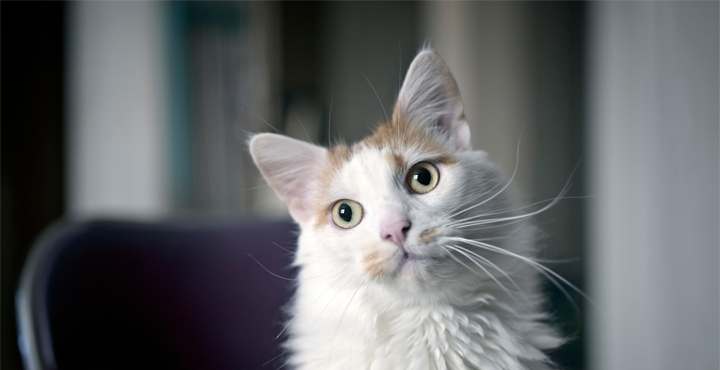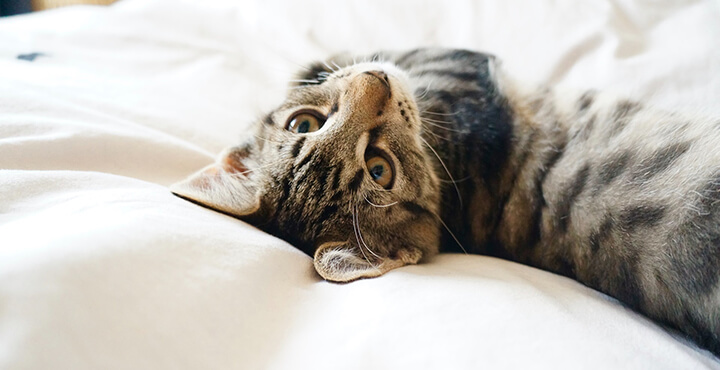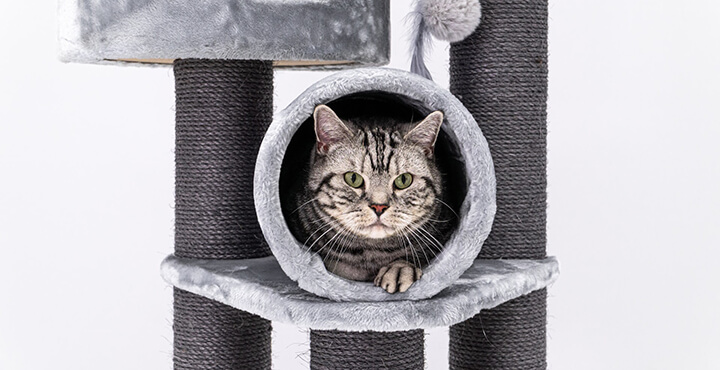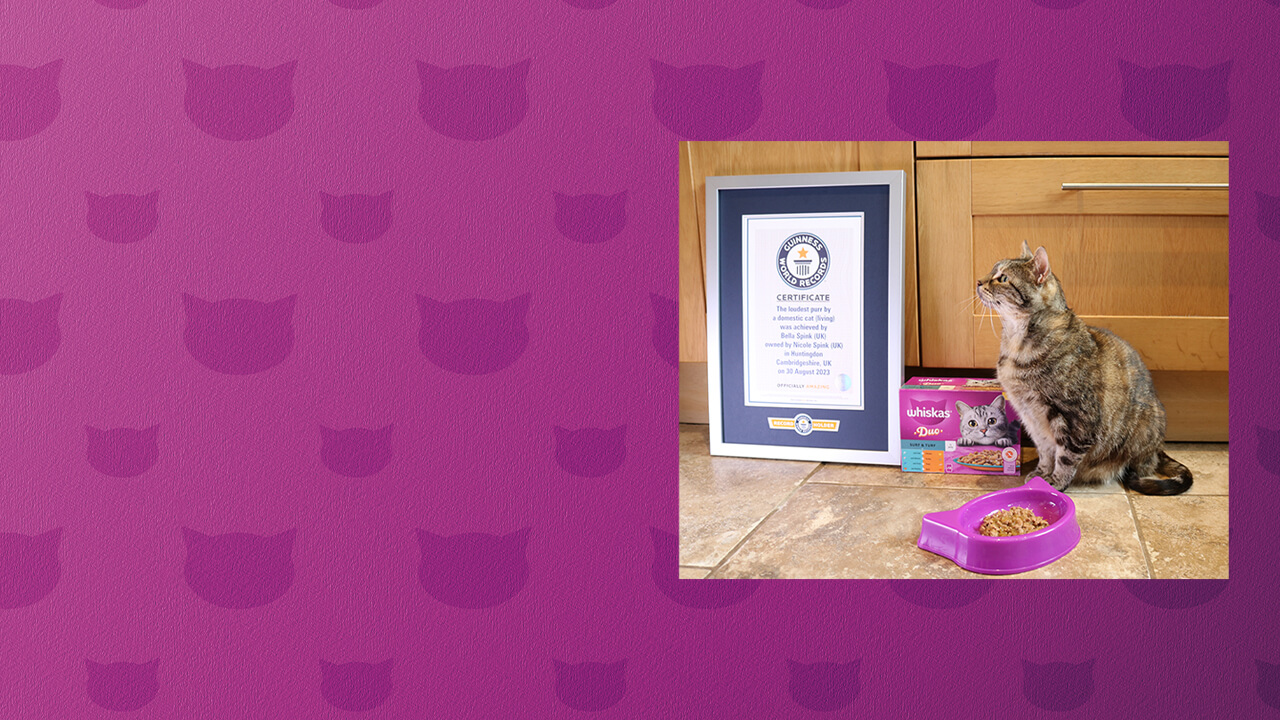
If there’s one thing cuter than a kitten, it’s a purring kitten! The sight of that tiny body vibrating, the oh-so-sweet sound. But what does it mean when a kitten purrs, what about the other little noises they make and how can you best communicate with them?
Is a purring kitten a happy kitten?
If you’ve read What does it mean when a cat purrs, you’ll know that, while a purr is often a cat’s way of communicating contentment, it isn’t always. The same is true for kittens. They will often purr because they’re enjoying something – a lovely snuggle with their mum and littermates, say – but you might also hear your kitten purr for different reasons. They could be asking for food (just like human babies, they do this a lot!) or they might be purring to soothe themselves because they’re stressed, unwell or in pain.
When do kittens first start purring?
When kittens are first born, they can’t see or hear, so the vibrations of a purr are a good way for their mums to communicate with them. The kittens will purr in response too, some within hours of being born but some not for a few days or even weeks. Purring isn’t just a form of communication between a kitten, their mum and their littermates though. It can also be something a kitten will do to self-soothe or when they’re interacting with people.
The different sounds your kitten makes
Your tiny furry friend is likely to make a fair few different noises, from the classic meow to a purr or a chirrup. In fact, cats have as many as 60 different types of vocalisations. Let’s take a look at the most common and what your kitten is likely to be trying to tell you:
The classic meow
Adult domestic cats don’t tend to meow to communicate with each other and use the meow more to ‘talk’ to their humans. Kittens, however, will usually meow to their mums, and there are many different types of meow, from low-pitched to high-pitched to short and sharp to repeated.
Trilling
This sounds like a cross between a meow and a purr. It’s used as a greeting, whether that’s between a kitten and their mum or a cat and a person.
The ‘chirrup’
Have you heard your kitten making a kind of ‘chirruping’ or ‘chirping’ sound that sounds almost as if they are imitating a bird or a small rodent? This common vocalisation varies in tone and can mean different things in different contexts. Your kitten might respond to a ‘chirrup’ from their mum to come, for example, or they might use it to get her attention. Kittens also ‘chirrup’ when they see something exciting they can’t get at, so if you see them at the window with their ears erect and a focused look, chances are they’ve seen a squirrel or a bird!
Chirping
Chirping is a sort of ‘ekekek’ noise that can be heard when a cat is hunting or excited.
The purr
It won’t come as any big surprise to know that a purring kitten is usually a happy kitten. A mother cat will purr at her newborn kittens and they will purr right back. Your little feline friend will also use their purrs to tell you something is making them feel happy and contented too, whether that’s a loving stroke or a tasty meal.
As we’ve already discovered though, while a purring kitten is usually a happy one, cats also purr to self-soothe, perhaps because they are unwell, in pain or stressed. Knowing what your kitten is trying to tell you with their purr is all about judging the context and how they seem in more general terms.
Communicating with your kitten
We’ve talked a lot about how our kittens communicate with us, but what about improving the way we communicate with them? How can we make sure we build a strong bond with our new furry friend? The crucial thing to remember here is that each and every kitten is a unique individual with their own personality. With this in mind, it’s great if you can take your cues from them. This involves getting to know all the different vocalizations we’ve looked at but also observing your furry friend’s body language.
If your kitten approaches you (a good sign in itself) with their tail up, they’re likely to be feeling in the mood to interact. However, a low to the ground posture or pinned back ears suggest your kitten isn’t feeling comfortable. It’s also important to realise that, while you might want to pet your new kitten constantly (so cute!), it’s best to make sure your attentions are welcome. Good tips are to offer your kitten your hand so they can choose to rub against it or petting your kitten a couple of times and seeing if they come back for more. It's worth noting that not all kittens and cats enjoy cuddles or being petted, but that’s fine and that we love them for who they are.
Making sure your kitten is content
Welcoming a new kitten into your home is one of the most exciting things you can do, but it can also create a certain amount of stress – after all, you want to make sure your new furry friend is happy. Here are a few tips to get things off to a good start.
Set yourself up for success
Before you bring your new kitten home, take the time to buy all the essentials you need and set up your home for your new arrival. Where are you going to put their bed? How about their litter tray and their food and water bowls? Remember, cats prefer these not to be too near each other, and out of busy, high-traffic areas.
Stock up on kitten food
When you’re looking for purrs of approval, one of the most important things to get right is your choice of kitten food. Initially, it’s a good idea to give your kitten whatever they have been eating at the breeders or rescue centre – this will help them to settle in and not disturb their tummy. When you’re ready to introduce new food, it’s best to do so gradually, mixing in a little of the new food every day. As kittens require specific nutrition to help them develop and grow healthily, we recommend feeding them dedicated kitten food. At Whiskas®, our kitten food contains everything your furry friend needs to grow and thrive and is also deliciously tempting. Did you know that if you give a kitten as much variety as you can when they’re young, this can help stop a fussy kitten growing up into a fussy cat?
Be patient
Moving is stressful for all of us, so it’s likely that your new kitten might take a little while to feel fully settled in their new home. This is completely normal. To make the whole thing as easy on your kitten as possible, try to give them space to investigate their new pad in their own time and offer quiet, safe spaces they can escape to. Last but not least, let them approach you in their own time.
Tell yourself you’re doing a great job!
The very fact you’re reading this shows you’re keen to make your new kitten happy and settled. Give yourself a pat on the back and remind yourself that if you give your new furry friend lots of love, you’re unlikely to go far wrong!
Looking to get more happy purrs around mealtimes? Check out our delicious kitten food and the advice in What to feed a fussy cat. For more tips on all things kitten, check out our advice hub.













